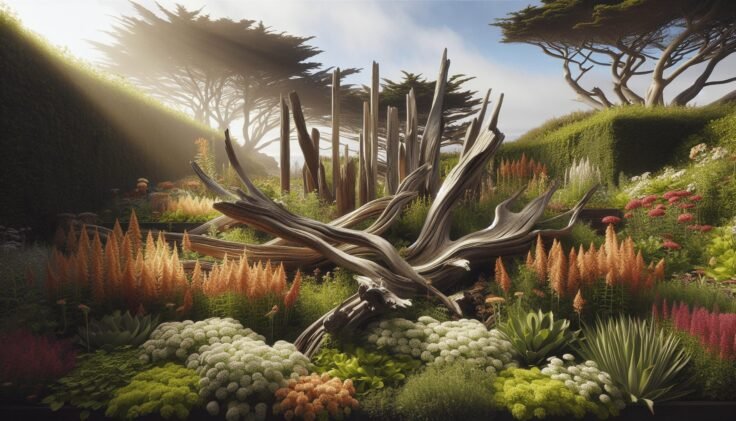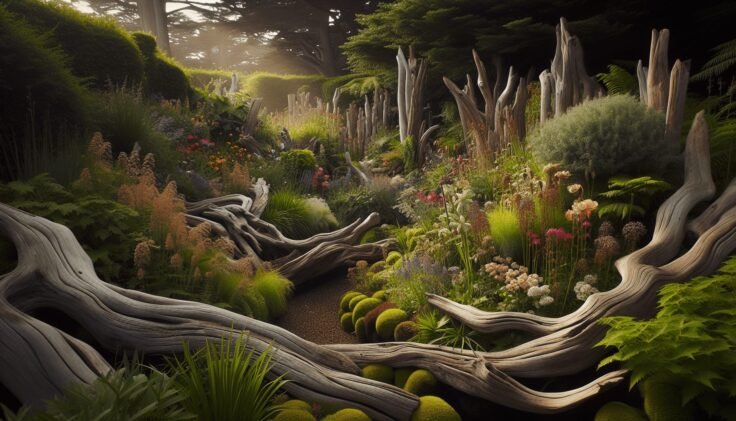Have you ever considered the beauty and functionality driftwood can bring to your garden or landscape? Driftwood landscape edging might be just what you need to add that unique touch to your outdoor space. It’s a simple, natural, and creative way to define boundaries and create visually appealing zones in your garden or yard.
What is Driftwood Landscape Edging?
Driftwood landscape edging involves using pieces of driftwood along the borders of garden beds, pathways, driveways, or any other part of your landscaping design. Driftwood, which is naturally weathered wood that has been washed onto shores, is an excellent choice for those looking to add a rustic and ecological touch to their outdoor spaces. By using driftwood, you not only enhance the aesthetic appeal of your garden but also make use of a renewable resource that reflects a natural part of the ecosystem.
The Appeal of Driftwood
Driftwood is known for its distinctive, weathered appearance, which can vary in color from pale beige to rich, deep browns and grays. These wood pieces often have unique shapes, adding character and charm to wherever they are placed. The natural beauty of driftwood makes it an ideal choice for various styles of landscaping, whether you’re going for a coastal theme, a woodland look, or something entirely unique and personalized.
Benefits of Using Driftwood
Incorporating driftwood has several advantages. It’s not only about aesthetics but also about how practical and eco-friendly this choice can be.
Sustainability
Driftwood is a sustainable material. Since it is naturally occurring and washes up on beaches, using it helps to minimize the environmental impact compared to processed or manufactured landscaping materials. Choosing driftwood supports recycling and sustainability by repurposing a naturally occurring resource.
Versatility
Driftwood can be used in a multitude of ways. From defining boundaries to creating raised garden beds or acting as a focal point, the versatility driftwood offers is remarkable. You can arrange it vertically, horizontally, or even interlock pieces to craft unique designs that fit your specific needs and preferences.
Durability
Driftwood is naturally resilient. Having endured time in the elements before arriving at the shore, it tends to be weather-resistant and durable, making it an excellent choice for outdoor applications. Its ability to withstand harsh weather conditions means that your driftwood edging can last for years without significant wear.

How to Incorporate Driftwood Into Your Landscape
Setting up driftwood as landscape edging is straightforward and can be a fulfilling project that adds value and intrigue to your landscaping efforts. Here’s a step-by-step guide to help you get started.
Finding the Right Driftwood
Begin by sourcing driftwood. Visit local beaches or riverbanks where driftwood naturally accumulates, or purchase pieces from garden supply stores that offer eco-friendly products. Ensure that collecting driftwood is allowed in your area and that you’re abiding by any local regulations.
Preparing the Area
Before placing your driftwood, prepare the area where you intend to install the edging. Clear any weeds, rocks, or debris, and level the ground. This groundwork ensures your edging will rest evenly and remain stable over time.
Arranging and Securing the Driftwood
Once your area is prepared, start arranging your driftwood pieces along the desired line. Consider patterns and designs, playing with the natural shapes of the wood to maximize visual appeal. To secure the driftwood, especially larger pieces, you might need to anchor them using stakes or partially bury them in the ground for additional stability.
Enhancing with Soil and Plants
Complement the natural appearance of driftwood by adding soil and planting hardy, low-maintenance plants along the edges. This will not only enhance the aesthetics but also stabilize the surrounding soil, preventing erosion and creating a lush, cohesive look.
Design Ideas and Inspirations
While setting up driftwood edging, creativity is your best ally. Here are a few design ideas to consider.
Curved Pathways
Create meandering pathways by lining walkways with driftwood. The fluid shapes of the wood work great with curved lines, adding a natural dynamic to your landscaping.
Raised Garden Beds
Leverage thicker driftwood pieces to build raised garden beds. Simply stack layers of driftwood and fill them with soil, creating defined planting areas that are both functional and attractive.
Fences and Partitions
Using driftwood to form diminutive fences or partitions serves dual purposes – providing privacy and defining areas. This technique can create cozy garden nooks or separate different sections of your garden effectively.
Tables for Design Variations
To assist with visualizing potential layouts, consider preparing a table detailing different designs and their potential applications.
| Design Variation | Application | Benefits |
|---|---|---|
| Curved Pathways | Garden paths | Softens landscape |
| Raised Beds | Vegetable or flower gardens | Increases planting depth |
| Fences | Garden borders | Provides privacy |
| Spaced Edging | Walkways or paths | Adds character without blocking views |

Maintenance Tips for Driftwood Edging
To keep your driftwood edging in excellent condition, regular maintenance is essential. Follow these practical tips to ensure long-lasting results.
Cleaning
Occasional cleaning will help maintain the wood’s natural color and prevent the accumulation of mold or mildew. Use a mild detergent and water solution, avoiding harsh chemicals that could damage the wood or harm nearby plants.
Rot Prevention
To protect against rot, especially in wetter climates, consider applying a natural wood preservative. Products made from plant-based oils can offer protection without introducing toxic substances into your garden environment.
Monitoring for Damage
Regularly inspect your driftwood for any signs of physical damage or decay. Promptly replace any compromised pieces to ensure your edging remains effective and beautiful.
FAQs on Driftwood Landscape Edging
You might have various questions about driftwood and its use in landscaping. Here are some common queries and their answers to assist you in making the most informed decisions.
Where can I find driftwood legally?
It’s crucial to ensure your driftwood collection complies with local laws. Public beaches and designated collection areas are typically safe, but always double-check regulations, specifically concerning protected coastal zones.
How can I prevent driftwood from moving during storms?
Securing the wood firmly in the ground is the best strategy. Use stakes or partially bury your pieces to enhance stability, reducing the risk of displacement during adverse weather.
Can using driftwood affect soil quality?
Driftwood generally does not harm soil. However, it can host various microorganisms that may enrich soil quality. If you notice any nutrient deficiencies, consider supplementary soil treatments or mulches.
Is driftwood suitable for all climates?
While driftwood is durable, extremely humid or dry environments may affect its longevity. Using preservatives can help it withstand harsh conditions, ensuring year-round beauty and performance.
Final Thoughts
Driftwood landscape edging embodies a blend of natural aesthetics, sustainability, and practical design functionalities. Embracing this style can give your garden or outdoor area a personalized touch that celebrates the natural world. When you choose driftwood, you’re making a choice that reflects an appreciation for nature’s artistry and a commitment to eco-friendly landscaping practices. So, why not give driftwood a try and transform your outdoor space into a captivating, harmonious environment?
By integrating driftwood into your landscape, you create a unique, serene, and inspiring outdoor retreat that resonates with the beauty of nature, ensuring years of enjoyment and appreciation.